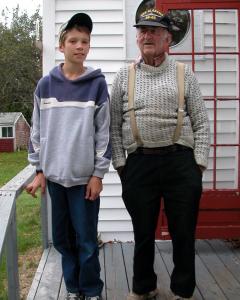Stan Simmons

Finding Friendship Oral History Project
The Finding Friendship Oral History Project is a joint effort of the Friendship Museum and the Friendship Village School, directed by Sally Merrick, museum volunteer, and Gaylea Hynd, teacher. In 2003-2004 sixth grade students conducted taped interviews of three generations of lobstermen and women, as well as others associated with the lobstering industry. Printed copies of the interviews and CDs of the printed transcripts are available at the Friendship Museum in Friendship, Maine.
Peggy Simmons
Stan Simmons was born on February 6, 1917. Now deceased, Stan Simmons was a lobster fisherman for 65 years. When he was eleven years old, he moved to Friendship from Bremen, Long Island. He has one adopted child and three grandchildren. In addition, he was a pilot and spotted fish for purse and stop seiners for seven or eight years. When he was asked what else he did, he replied, “You name it--everything but deliver babies.” He served in the Navy for two stints during World War II in the Pacific, where he delivered guerilla fighters to Japanese Islands, and for two years, he was stationed on the battleship USS Alabama, for which he named his lobster boat.
Scope and Content Note
This oral history interview conducted by Randall on October 17, 2003, at Stan Simmons' home provides insights into the life and experiences of Stan Simmons, a lobsterman from Friendship, Bremen. Simmons shares details about his early years, his extensive experience as a lobsterman for over six decades, and his involvement in World War II. He describes the tradition of lobstering in his family, the evolution of lobster boats and equipment, and the changes he witnessed in the lobstering industry throughout his career. Simmons also discusses the challenges and rewards of lobstering, including the impact of weather conditions on fishing and the fluctuating prices of lobsters. He describes lobstering in the old days, including building and setting wooden traps, as well as the whole process of lobstering. He also talks about breaking down off Monhegan Island in a hard blow and describes how he likes to prepare a lobster to eat on the boat, cooking it on the manifold of his gas-burning engine.
Please Note: The oral histories in this collection are protected by copyright and have been created for educational, research and personal use as described by the Fair Use Doctrine in the U.S. Copyright law. Please reach out Voices@noaa.gov to let us know how these interviews are being used in your research, project, exhibit, etc. The Voices staff can help provide other useful resources related to your inquiry.
The NOAA mission is to understand and predict changes in climate, weather, oceans, and coasts, to share that knowledge and information with others, and to conserve and manage coastal and marine ecosystems and resources. The Voices Oral History Archives offers public access to a wide range of accounts, including historical materials that are products of their particular times, and may contain offensive language or negative stereotypes.
Voices Oral History Archives does not verify the accuracy of materials submitted to us. The opinions expressed in the interviews are those of the interviewee only. The interviews here have been made available to the public only after the interviewer has confirmed that they have obtained consent.
